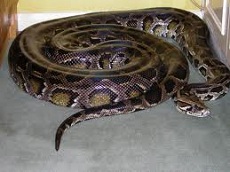Though Indian pythons are large and frightening looking, they are not venomous, and in fact are very attentive parents when judged against other snake species. Sadly, though, their beautiful skins have become popular, and the Indian python is endange
The Indian python is not really as threatening as it looks. It is very large – twelve or so feet long – and able to climb trees and swim, but it isn’t venomous. This python is found throughout India, Pakistan, Sri Lanka, and Nepal.
The Indian python belongs to the Boidae family of snakes, which is the family containing the world’s largest snake species, including anacondas and boas. The subspecies Python molurus molurus, shares its species classification with the Burmese python, though it is somewhat smaller and lighter in color. Their skin is very beautiful and used to make tourist products, and the meat is eaten locally in the states of Kerala and Tamil Nadu. Indian pythons do have partial protection from the Tamil Nadu Government, however.
Indian pythons live in woodlands, forests, river valleys, swamps, grasslands, and marshes. It depends on access to a continuous water supply. A typical adult weighs from 32 to 55 kg, and can be up to 12 feet long. Their normal lifespan is 20 to 30 years, and their diet mostly consists of whole birds and mammals.
The female Indian python has unusual reproductive habits when compared to most snakes. Both genders become mature at about three years old. About three or four months after mating, the female lays a single, huge clutch of eggs that may number up to 100. Although most snakes do not attend their eggs after they are laid, the Indian python does. With her eggs in a pile, she coils herself around them and guards them from predators until they are hatched, about two or three months. She will only occasionally leave the eggs for water, and rarely, to eat.
The female has to keep her eggs warmer than the environment, and this requires constant diligence, particularly since snakes are cold blooded. She will twitch her muscles constantly to keep her body temperature warm enough to incubate the eggs. When the baby pythons hatch, they are about 45 to 60 cm long, and will leave the nest very soon after hatching. Within a week or two, the babies will have their first shed of skin. In their first year, they can double or even triple in length!
In their natural habitat, Indian pythons spend most of their time on the ground, but they can climb trees and swim, too. Their skin pigmentation and markings allow them to blend in well with their surroundings. When the python is ready for a meal, it will lie in ambush until a preferred prey passes by. They have heat-sensing pits on their upper lips that actually detect nearby prey’s body heat. Once the prey is in range, the python grabs it in its jaws, then wraps around the animal and constricts it until the prey suffocates. They do not crush the prey. The Indian python can swallow whole prey the size of a small deer. Afterwards, it can go for months without eating again.
Indian pythons are very impressive snakes due to their size and their beautiful markings. While they may look very intimidating, they are not venomous. Sadly, their numbers are dwindling because of habitat destruction and use of their skins for making tourist souvenirs.





